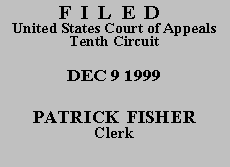 UNITED STATES COURT OF APPEALS
UNITED STATES COURT OF APPEALS
 UNITED STATES COURT OF APPEALS
UNITED STATES COURT OF APPEALS
TENTH CIRCUIT
| UNITED STATES OF AMERICA, | |
| v. | No. 99-1294 |
| RODNEY McFARLIN, | (D.C. No. 98-CR-243-N)
(D. Colo.) |
ORDER AND JUDGMENT(*)
Before SEYMOUR, Chief Judge, BALDOCK, and HENRY, Circuit Judges.(**)
Defendant Rodney McFarlin pled guilty to selling methamphetamine and guns to a federal agent. He appeals the district court's enhancement of his sentence pursuant to U.S.S.G. § 2D1.1(b)(1) for possession of a dangerous weapon during a drug sale. We exercise jurisdiction under 18 U.S.C. § 3742(a), and affirm.
Defendant was a member of a conspiracy that sold methamphetamine in Colorado Springs, Colorado. On December 18, 1997, Defendant sold two guns to Special Agent Scott Thomasson. On December 27, Defendant drove up in his truck for another meeting with Agent Thomasson, parking the truck within the agent's view. Defendant and a confidential informant proceeded to sell Agent Thomasson 119 grams of methamphetamine. Then the agent asked Defendant if he had any more guns for sale. Defendant asked the informant go to the cab of the truck to retrieve an unloaded gun, which Defendant then sold to the federal agent.
After his arrest and indictment, Defendant agreed to cooperate with the government and pled guilty to (1) conspiracy to possess with intent to distribute methamphetamine in violation of 21 U.S.C. §§ 846, 841(a)(1) and (2) being a felon in possession of a firearm in violation of 18 U.S.C. § 922(g)(1). The district court enhanced Defendant's sentence two levels pursuant to U.S.S.G. § 2D1.1(b)(1) for possession of a dangerous weapon during a drug sale, finding that it was not clearly improbable that Defendant's possession of the weapon was related to the drug transaction:
Here, defendant arrived to make the drug sale in his truck. After the sale was complete, he and the undercover agent agreed to the gun transaction. Defendant sent the informant to his truck to retrieve the weapon, all within the view of the agent. I find a direct spatial and temporal connection between the weapon and the drugs, notwithstanding that the sales were separate.
The district court sentenced Defendant to 112 months imprisonment and 5 years of supervised release, a downward departure from the imprisonment range of 188 to 235 months.
We review the district court's factual determination that Defendant possessed a dangerous weapon during the commission of the offense for clear error. See United States v. Dickerson, ___ F.3d ___, 1999 WL 961189, at *4 (10th Cir. 1999). "Once the government establishes that the gun was possessed in [temporal or spatial] proximity to the drugs or transaction, the burden shifts to the defendant to show it is clearly improbable that the weapon was related to the offense." United States v. Flores, 149 F.3d 1272, 1280 (10th Cir. 1998), cert. denied, 119 S. Ct. 849 (1999) (internal quotations omitted). "[E]nhancement under § 2D1.1(b)(1) is designed to reflect the increased danger of violence when drug traffickers add firearms to the mix." Id. The relationship between the weapon and the drug offense is not clearly improbable merely because the gun was not readily accessible during the drug offense. See United States v. Nguyen, 1 F.3d 972, 973 (10th Cir. 1993). See also United States v. Roberts, 980 F.2d 645, 648 (10th Cir. 1992) (upholding a § 2D1.1(b)(1) sentencing enhancement despite the fact that the guns were unloaded).
Defendant argues that because the sale of the drugs and the sale of the gun were separate transactions, his possession of the weapon was not related to the drug sale. Defendant further argues that the gun's presence did not increase the danger of violence because the gun was unloaded and because he possessed the gun not for use but for sale. These facts, however, do not meet Defendant's burden of showing that the district court clearly erred in finding that Defendant's possession of the gun was related to the drug sale. The proximity of the gun and the drugs is sufficient evidence of relatedness, even if the transactions were separate. Defendant's contentions that the gun was intended for sale, was unloaded, and was not readily accessible do not show that there was no increase in the danger of violence. Accordingly, the decision of the district court is
AFFIRMED.
Entered for the Court,
Bobby R. Baldock
Circuit Judge
*. This order and judgment is not binding precedent, except under the doctrines of law of the case, res judicata, and collateral estoppel. The court generally disfavors the citation of orders and judgments; nevertheless, an order and judgment may be cited under the terms and conditions of 10th Cir. R. 36.3.
**. After examining the briefs and appellate record, the panel has determined unanimously that oral argument would not materially assist the determination of this appeal. See Fed. R. App. P. 34(a)(2)(c); 10th Cir. R. 34.1(G). This case is therefore ordered submitted without oral argument.